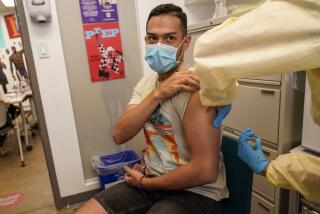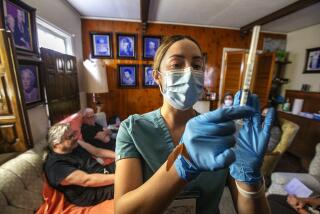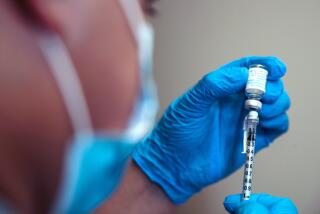Medical Workers Waver on Smallpox Shots
- Share via
When the word came late last year that public health officials would be the first to be immunized for smallpox, Dr. Margaret Beed had to make a decision.
Although she is the chief medical officer for public health at the Orange County Health Care Agency, she also had to consider the potential side effects if she volunteered for the vaccination: encephalitis, severe skin infections and fever.
She said she thought, “Oh, my God. What if that’s me -- that one in a million, one in 2 million [who die from the vaccine]? It’s kind of scary. What if I waited two years and there was a better vaccine?”
Back and forth she went for more than two months. First she was set to be vaccinated. Then the fear returned. Finally, her husband, also a pediatrician, persuaded her. He reminded her of Todd Beamer, who led passengers on the jet that crashed in a Pennsylvania field on Sept. 11, the man who said, “Let’s roll.”
“This is something we can potentially do to help in this terrorist situation,” the 51-year-old Beed said. “It’s a small thing compared to people who’ve lost their lives.”
Thousands of health-care workers around the country are asking themselves similar questions as they decide whether to step forward for smallpox vaccinations. Some areas, including Ventura and Los Angeles counties, already have begun vaccinating what they call their “first responders” -- those who would help the stricken in any bioterrorism attack.
Those doctors, nurses, social workers, epidemiologists and even office assistants must balance the conflict between their job to ensure public health against fears for their own safety. More than 200 of 1,100 people in eligible jobs at the Orange County Health Care Agency have volunteered to be vaccinated.
Those who do not want to be vaccinated did not have to give a reason. It’s entirely voluntary.
“We don’t regard it as our business if someone chooses not to be vaccinated,” said Penny Weismuller, division manager for disease control and epidemiology for the agency.
Some conditions automatically bar people from receiving the vaccination, including a history of eczema and active cases of chickenpox, shingles, herpes, severe acne or psoriasis.
Women who are pregnant or breast feeding also are exempt. People with weakened immune systems, such as those with HIV, organ transplants, autoimmune disorders or undergoing cancer treatment, also should not be vaccinated. Nor should people younger than 1 or older than 65.
Orange County Health Care Agency staff are given every opportunity to pull out of the program. Before they receive the shots, they will undergo more extensive screening, and doctors and public health nurses will be available for those with questions.
A second phase of the vaccination program will involve hospital and clinic personnel, who also have the option of refusing.
So far, the number of volunteers among these health workers is lower than expected, county health officials said. One entire hospital, South Coast Medical Center in Laguna Beach, has opted out of the program, and others could follow, they said.
The county has received the freeze-dried solution that makes the vaccine and plans to begin administering it within two weeks after presenting a plan to the county Board of Supervisors, possibly as early as Tuesday.
Smallpox is a highly contagious, sometimes fatal disease. The last case in the U.S. was recorded in 1949. The last case worldwide was in Somalia in 1977, and routine vaccination was stopped. The Bush administration, though, fears that Iraq, North Korea and terrorist groups may hold stockpiles of the virus to use as a weapon.
“It was one of the worst diseases we have had,” said Dr. Bruce Haynes, Orange County’s director of emergency medical services. “When you compare the vaccine to that history, it was an easy decision to get the vaccine.”
The vaccine is made from a virus related to smallpox and can cause, in most cases, only fever and body aches.
One to two people per million die as a result of the vaccine, and 1,000 people per million suffer serious but not life-threatening reactions, according to the Centers for Disease Control in Atlanta.
Debbie Mulligan, the infection control nurse at South Coast Medical Center, who also works at Mission Hospital Regional Medical Center in Mission Viejo, is one of those health professionals who says she won’t be vaccinated.
Mulligan is 47. Like Beed, she has three children.
She’s worried the vaccine could rub off on patients who have compromised immune systems and make them sick. “We have a hard-enough time making sure people keep their hands washed,” she said. “What if somebody inadvertently itches themselves and then touches a compromised patient who has a wound?”
*
(BEGIN TEXT OF INFOBOX)
The disease
Smallpox is a highly contagious disease caused by the variola virus. The most serious form has a fatality rate of 30% or more. In the 20th century, an estimated 300 million people died of smallpox worldwide. Here’s a look at the disease and how it evolves:
Exposure
How it spreads: By inhaling infected saliva droplets, usually through coughing; direct contact with scabs, bedding or contaminated clothing.
Phases and duration
Incubation period (seven to 17 days) Not contagious
Initial symptoms (two to four days) Sometimes contagious.
First symptoms include fever, malaise, head and body aches.
Early rash (About four days) Most contagious
Pustular rash (About five days) Contagious. Rash turns into small blisters that become pustules.
Pustules and scabs (About five days) Contagious
Resolving scabs (About six days) Contagious
Scabs resolved Not contagious
Treatment/Prevention
Vaccination: Will prevent infection from three to five years, with decreasing immunity after that. The vaccine contains another virus called vaccinia. It does not contain smallpox virus. The vaccine can produce serious side effects, from severe rashes to brain inflammation, killing an estimated
one in 1 million.
Treatment: There is no treatment or cure, but vaccine given within four days of exposure can reduce the severity.
Vaccine stockpiles
There are currently enough doses to vaccinate everyone in the U.S. in case of an outbreak.
*
Sources: Centers for Disease Control and Prevention; American Medical Assn.; Johns Hopkins University; and Times archives. Researched by Maloy Moore and Jeff Gottlieb/Los Angeles Times



